 Chanting combines singing and music with mantras. The sweetness of chanting stills the mind, dissolves worries and opens the heart. Chanting forms an integral part of the practice schedule at siddha yoga retreats, centres and ashrams. Here is an electronic chant player for some popular mantras and artis.
Chanting combines singing and music with mantras. The sweetness of chanting stills the mind, dissolves worries and opens the heart. Chanting forms an integral part of the practice schedule at siddha yoga retreats, centres and ashrams. Here is an electronic chant player for some popular mantras and artis.
3-in-1 Chant Player Circuit
At the heart of these circuits is a pre-programmed read-only memory (ROM) chip bonded on a hylam board. (The ROM chip is a complementary metal-oxide semiconductor (CMOS), large-scale integrated (LSI) chip.) Known as chip-on-board (COB), these boards are available in different sizes, under a blob of epoxy, with chips programmed with single or multiple mantras/artis such as gayatri mantra, ganapati mantra, krishna mantra, om namah shivaye, shri ram jai ram and satnaam wahe guru.
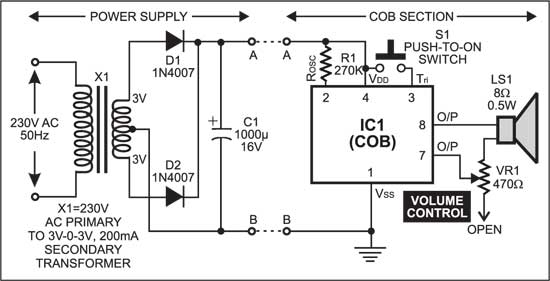
The COBs are available in 7-, 8-, 9- and 16-pin pad configurations. Pin connections of these COBs are shown in Fig. 6, Figs 1, 2 and 4, Figs 3 and 5, and Fig. 7, respectively. Some manufacturers make these COBs with different pad configurations, so their specifications should be strictly followed.
Besides a preprogrammed data ROM, the COBs contain an inbuilt oscillator, counter, shift register, adaptive differential pulse-code modulation (ADPCM) synthesiser and digital-to-analogue converter (DAC).
Circuit operation
The timing pulses generated by the oscillator regulate the pace of the mantra and other activity inside the chip. Its frequency is decided by an external resistor (Rosc) connected between its two input pins. The controller controls all the activities inside the chip. It sends appropriate signals to the counter and the shift register to read the data in the ROM. The output of the ROM is fed back to the controller, which directs it to the ADPCM synthesizer. The synthesizer’s output is sent to the DAC, which converts it into audio. The audio output from the DAC is reproduced by the loudspeaker. The potentiometer connected to the input of the loudspeaker acts as a volume controller.
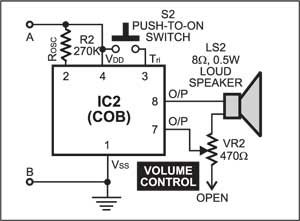
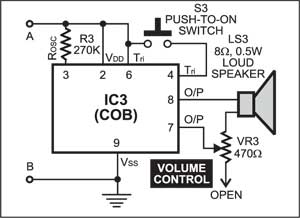
The COB works off 3V DC and is capable of driving the loudspeaker directly.
Fig. 1 can be divided into power supply and COB sections. The same power supply section is to be used for the COB circuits shown in Figs 2 through 5 as well. The 3V power supply for the COB is derived by using a 3V-0-3V center-tapped transformer (X1). The secondary output of the transformer is applied to a full-wave rectifier comprising diodes D1 and D2. The output of the full-wave rectifier is filtered by capacitor C1 to provide 3V DC to the COB.
For 3-in-1 mantra player, connect A and B terminals of the power supply section to the corresponding points of the COB section as shown in Fig. 1. Then connect 230V AC mains to the primary of transformer X1. Now the circuit is ready to play.
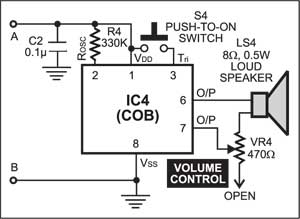
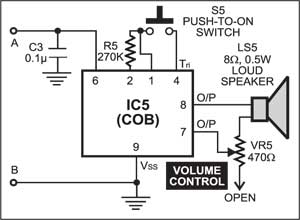
The desired mantra can be selected by applying positive supply to trigger pin 3 of IC1 by pressing push-to-on switch S1 momentarily. When you press switch S1 for the first time, “wahe guru” is played. “Satnam wahe guru” is played when you press S1 second time. When you press switch S1 third time, “satnam karta purush” is played. Using preset VR1, the volume of the sound can be controlled.
2-in-1 mantra player
For 2-in-1 mantra player, connect the power supply section of Fig. 1 to the COB section shown in Fig. 2. The desired mantra can be selected by applying positive supply to trigger pin 3 of IC2 by pressing push-to-on switch S2 momentarily. When you press switch S2 for the first time, “jai ganesh jai ganesh deva” is played. When you press switch S2 second time, “aarti kijje hanuman lala ki” is played.
6-in-1 player
For 6-in-1 mantra player, connect the power supply section of Fig. 1 to the COB section shown in Fig. 3. The desired mantra can be selected by applying positive supply to trigger pin 4 of IC3 by pressing push-to-on switch S3 momentarily. When you press switch 3 for the first time, the circuit starts playing “om bhurbhua swaha” When you press switch S3 second time, “om namah shivaye” is played. When you press switch S3 third time, “jai ganesh, jai ganesh deva” is played. “Govind bolo hari gopal bolo” is played when you press S3 fourth time. When you press switch S3 fifth time, “shriman narayan narayan” is played. When you press switch S3 sixth time, “om krishna yadhamah” is played.

For 5-in-1 mantra player, connect the power supply section of Fig. 1 to the COB section shown in Fig. 4. When you press switch S4 for the first time, “om bhurbhua swaha” is played. On consequent pressing of switch S4, “om namo shivaye,” “jai ganesh, jai ganesh deva” “jai siya ram” and “govind bolo hari gopal bolo” are played in that order.
For another 2-in-1 mantra player, connect the power supply section of Fig. 1 to the COB section shown in Fig. 5. When you press switch S5 for the first time, “om bhurbhua swaha” is played. When switch S5 is pressed second time, “om namah shivaye” is played.
1 mantra player
The circuit for playing a single mantra with loud sound is shown in Fig. 6. The circuit comprises power supply, COB (shown within dotted lines) and low-power audio amplifier sections. Low-power audio amplifier IC LM386 (IC6) is used here to get louder sound.
The power supply section uses a 6V-0-6V centre-tapped transformer (X2) instead of the 3V-0-3V centre-tapped transformer. The secondary output of the transformer is rectified by a full-wave rectifier comprising diodes D3 and D4, and filtered by capacitor C4 to provide 6V DC to the power amplifier (IC6). Zener diode ZD1 in series with resistor R6 reduces the supply voltage to 3V for the COB section.
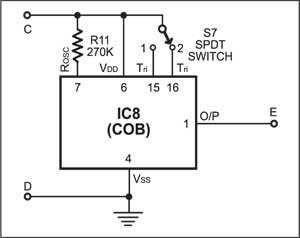
Connect all the three sections together by connecting their identical terminals. Then connect 230V AC mains to the primary of transformer X2. Now the circuit is ready to work. Simply press switch S6 to provide the power supply to IC6 and IC7 and “om namah shivaye” start playing loudly. Using preset VR6, you can control the volume of the sound.
2 mantra player
For a 2 chant player with loud sound, disconnect the COB circuit shown within dotted lines in Fig. 6 and replace it with the COB circuit shown in Fig. 7. The desired mantra can be selected by applying positive supply to trigger pin 15 or 16 of IC8 by changing the position of switch S7. Note that switch S6 should be kept pressed.
When switch S7 is in position 1, “shri krishanah sharnam namah” is played. The mantra repeats continuously. To stop it, either release switch S6 or shift switch S7 to position 2. If you choose to shift switch S7, “shri krishana” stops playing but “hari krishana, hari krishana” starts playing. The mantra repeats continuously. To stop it, either release switch S6 or shift switch S7 to position 1.
For ease of construction, assemble a small printed circuit board (PCB) for the amplifier and power supply circuits. Various types of plastic enclosures for electronic chanting players are available in the market. Use a suitable enclosure for this player. Take care while handling and soldering the COBs as the CMOS chips can get damaged due to static charge.
The article was first published in December 2004 and has recently been updated.









Dear / Sir :
Hope you are doing well,
This is from DJ LED LIGHTING INDUSTRIES
We are a trading company with office in Kalaburagi ( Gulbarga ) Karnataka India.
We need Chanting mantra circuit and box
Can you send me prices of your products also let me know your Minimum. Order
Payment terms and delivery Time.
Thanks and Best Regard
DJ LED LIGHTING INDUSTRIES
[email protected]
L C BUJURKE
9686499777
Sir :
We are a religious item traders in Bengaluru India.
We need Chanting mantra COB for the customer supplied Slokas with and without box.
Please send prices also let me know your Minimum. Order
Payment terms and delivery Time.
Thanks
Kshama Shirole
[email protected]
9945530904
Is there any Chanting Mantras Box/Player available with sd card option so we can use our own mantras, aaratis, slokas? I contacted manufacturer if they can make customize mantra boxes for 5-10 pieces. But everybody refused to make, i don’t know why. I don’t know what to do.
Hello Gourav, Can you provide the contact number of COB or Chanting Mantras Box manufacturer. My mobile number is 7620521919
jai gomata,
I am DS Raghvaendra bangalore i want this chanting box 9916134444
I need to learn this how to make it. can you please let me know what will be costing for one audio clip for chanting box or what ever.
Thank you.
Balakrishna.
9945852391
i wan t2in1 chanting machine parts & boxes quantity. 1100 nos. give us rates & delivery period for the same
Dear Sir,
Please call me or message me
Sambasivam 944 3578 649
Dear sir,
We manufacture Chanting Mantras Box/Player transformer as per your technical requirement and at of transformer design all engineering factor consider. So requirement about transformer please contact to our company.
Thanks & Regards
Renuka Enterprises
Address: Plot No. 167/1, Near Khuthwad Nagar, Satpur MIDC, Nashik-422007
Contact No. 8378862474
Mail Id: [email protected]
Hi. Greetings
I want to manufacture a chanting box for a particular mantra. Can i call you please
This is Kannan.SRS
I want to start manufacturing of chanting box. I want details of where the required material can be obtained and costing of parts etc.
I want to start manufacturing of chanting box. I want details of where the required material can be obtained and costing of parts please contact 9734769469
Dear sir,
I would like to connect a bulb with the chanting circuit in a single connection. When I switch on the system both the bulb as well as the chanting box should operate. I prefer usb port chanting box. Could you please advise me in this regard.
Thanks,
Kumar
Hello,
I hope you recieve this. I am in the UK and wondered if I could purchase or you could tell me where to purchase the 6 in 1 set up. Rather than chants (although I do love chants) I would like to use the circuit to play 6 looped sounds (e.g. a looping wind sound). I will then be integrating into a box with batteries, volume, push-to-on witch and speaker.
Is this somehting you can help with?
Best regards,
Andrew
The circuits include old ICs. You can find more recent ICs used in the project here.
Where can I buy Voice COB IC for repairing my Matra box.
The same ICs are not available now. The design is for reference.
I want to buy in bulk, but customised chant box
Greetings. I want to manufacturer a particular manthira chanting Box
Can you please let me know the details how to proceed further
God bless you
I want to buy the music mantra circuit or ic. I want it 5 pieces.
if we give the songs will you give the circuit along with the box please let me know